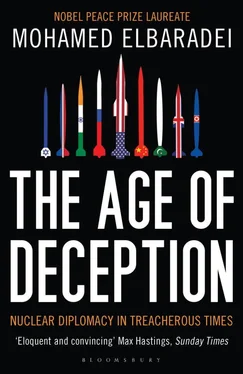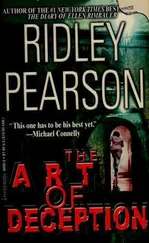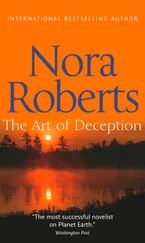In the aftermath of the discovery of Iraq’s clandestine nuclear program, I made a couple of visits to Washington, meeting with many people from Congress and the executive branch. The question on everyone’s mind was why, over the years, had the IAEA missed the buildup of Iraq’s undeclared nuclear program. I was candid about the flaws in the system. I emphasized the Agency’s need for additional legal authority. The time was ripe. Nobody could argue that the NPT safeguards system was working properly. Iraq’s program had been uncovered only after a military defeat.
Back in Vienna, at the IAEA Secretariat, we had begun work on the concept of a Model Additional Protocol to make the Agency’s in-country verification authority more robust and explicit. As conceived, the Additional Protocol would be an add-on to the safeguards agreement each NPT member country was required to make with the IAEA.
It was a complex endeavor: a mix of technical, legal, and policy considerations. A frequent focus of discussion was how much inspection Member States would tolerate. This was not a new question. At the time of negotiating the NPT, a key sticking point had been the unwillingness of countries to give the IAEA too much oversight authority. [20] The focus of IAEA verification at the time was large industrial countries, such as Japan, Germany, Italy, and Canada, since most developing countries did not have significant nuclear infrastructure.
The deliberate deception carried out by Iraq had made clear that conducting international safeguards by “honor code” was no longer adequate; nor was it enough to inspect only what a country declared; nor was the IAEA authority sufficient. But these realities, while widely recognized, gave us no guarantee that Member States would subject themselves to more intrusive oversight.
Unfortunately, the process of developing the Model Additional Protocol led to a disagreement between Hans Blix and me. I argued for the involvement of Member States. Blix favored keeping the development of the protocol in the hands of the Secretariat. We had the necessary expertise, he argued. The IAEA staff should write the draft, bring it for consideration to the Board of Governors—comprised of representatives of thirty-five Member States—and continue a review and revision process until it was approved. Blix believed that putting the initial drafting in the hands of Member States meant that the protocol would go nowhere.
It soon became apparent that Blix’s approach was not working. In order to gain Member State buy-in for the Additional Protocol concept, they needed to be involved in its creation. I proposed to Blix that we create a working group, with Board member involvement. Blix was completely resistant to the idea.
A number of Member States began to see their exclusion as a lack of openness on the part of the IAEA in developing what would clearly become a critical and influential policy mechanism. Representatives from a group of ten Western countries, a group we referred to as the “white angels” because of their staunch support for nonproliferation, came to see me. They asked me to tell Blix to let go of the Secretariat’s “hold” on the Additional Protocol and to allow the Board to get engaged. Of course I spoke to Blix about it, and of course he did not appreciate that they had not come to him directly.
This rather trivial incident marked the beginning of palpable tensions that would continue between the two of us. Perhaps he thought that I was working behind his back. In any case, it was unfortunate—especially since it had been Blix who had first recruited me to work for the Agency and under whom I quickly moved through the ranks from legal adviser to assistant director general for external relations.
The struggle continued behind closed doors. Eventually, the chairman of the Board at that time, Canadian ambassador Peter Walker, simply informed Blix that he was taking over the task and asked for the Secretariat’s support. Richard Hooper, a director in the Safeguards Department who was quite adept on safeguards concepts, was made the lead technical person. I was made the lead on legal and policy issues. The Board chairman also chaired the working group. Blix did not attend any of the sessions. It was a long and complicated exercise, with many governments on the defensive. The toughest battles were political; success was in large part due to deft diplomacy by a number of key players.
Finally, on May 13, 1997, the Model Additional Protocol was adopted by the IAEA Board of Governors. It was a breakthrough legal instrument that would strengthen the effectiveness of the NPT safeguards system. So what had changed? In countries that accepted the Additional Protocol, IAEA inspectors had more freedom on the ground, with more access to information and sites, and could now search more effectively for undeclared nuclear material and facilities. In the past, the IAEA could theoretically invoke the right to look for undeclared material and facilities through a “special inspection” mechanism. But special inspections were arduous to invoke and had almost never been used. The Additional Protocol enabled greater access as a routine matter.
The adoption of the Model Additional Protocol, a major milestone in the history of nuclear safeguards, had the potential to effect great change. For countries that had only a safeguards agreement in place, the IAEA was expected to provide assurance that declared nuclear material and facilities had not been diverted for non-peaceful purposes. But for those that brought an Additional Protocol into force, the IAEA could provide, in addition, the equally important assurance about the absence of undeclared nuclear material and facilities.
There was only one catch: whereas the safeguards agreement was compulsory for NPT members, the Additional Protocol was a voluntary mechanism. It remains so today. NPT members are not obliged to accept it, whatever the amount of prodding by the IAEA or from fellow Member States.
Here lies another major tripping point in the public understanding of the IAEA’s role. The Agency is, in a sense, at the mercy of those it oversees. It can exercise only the authority it is given. When I began traveling in Arab countries as the IAEA Director General, for example, it was common for me to take strong criticism for the IAEA’s failure to “do something” about Israel’s nuclear program. I could explain as often as I liked that we had no authority to inspect Israel’s facilities: Israel, while a member of the IAEA, has never signed the NPT, much less concluded a comprehensive safeguards agreement with the IAEA. [21] This is often a point of confusion. By joining the IAEA (becoming a “Member State”), a country pledges to uphold the principles of the IAEA statute and thus gains access to proliferations discussions. However, this does not obligate that country to accept IAEA verification of its nuclear material and facilities. That legal obligation comes with joining the Nuclear Non-Proliferation Treaty and, pursuant to the treaty, concluding a comprehensive safeguards agreement with the IAEA.
The aggravated Arab public, however, couldn’t have cared less; as far as they were concerned, we were biased and shirking our responsibility.
In fact, if the general public fully understood the continuing unevenness of the IAEA’s authority, I believe there would be even greater concern. The challenge is how to raise that public awareness.
Consider the present circumstance. At the end of 2010, thirteen years after the introduction of the Model Additional Protocol, many NPT member countries have not even brought into force their required comprehensive safeguards agreements with the IAEA. [22] While it is compulsory for countries party to the NPT to conclude safeguards agreements with the IAEA, the Agency has no power to penalize those who fail to do so.
And out of 189 members of the NPT, just 103 countries so far have brought an Additional Protocol into force. For the large number of countries remaining, when it comes to providing the international community with the assurance it desires, the IAEA’s hands remain tied.
Читать дальше












